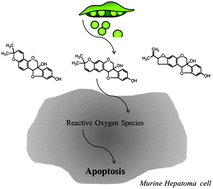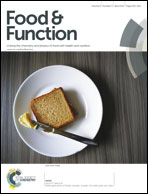Soybean-derived glyceollins induce apoptosis through ROS generation
Abstract
Glyceollins, which are synthesized from daidzein in soybeans infected with fungi, have been shown to have anti-fungal effects and antioxidant properties. However, the anti-proliferative mechanism of glyceollins against tumor cells is unknown. Glyceollin-induced apoptosis was evidenced by a decrease in cell viability and mitochondrial membrane potential, and an increase in early redistribution of plasma membrane phosphatidylserine, the sub G1 phase, and DNA fragmentation in hepa1c1c7 cells. Western blot analysis showed that treatment of the hepa1c1c7 cells with the glyceollins decreased the expression of pro-caspase-3, Bcl-2, and cell cycle-related proteins, but increased the expression of p21 and p27, and cytochrome C release into cytosol. At a concentration of 6 μg mL−1 or higher, glyceollins significantly stimulated the production of reactive oxygen species (ROS), which appear to be responsible for the apoptotic activity of the compounds. Our present study demonstrated that the high dose of glyceollins possibly caused apoptosis in mouse hepatoma cells through the production of ROS, suggesting the potential to exploit glyceollins as anti-tumorigenic agents.


 Please wait while we load your content...
Please wait while we load your content...